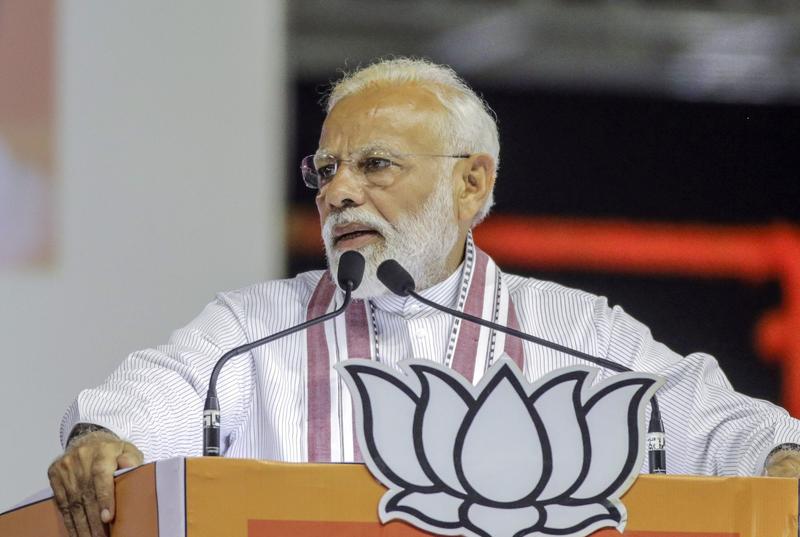 This undated file photo shows Indian Prime Minister Narendra Modi speaking. (PHOTO / BLOOMBERG)
This undated file photo shows Indian Prime Minister Narendra Modi speaking. (PHOTO / BLOOMBERG)
India’s eastern state Bihar goes to polls Wednesday in an exercise spread across two weeks. The election is the first test for Prime Minister Narendra Modi and his Hindu nationalist Bharatiya Janata Party since the COVID-19 pandemic struck. A strict nationwide lockdown has resulted in the country’s worst economic downturn in decades and both unemployment and virus infections have soared. India trails only the US as the nation with the most highest case tally.
The election will be the first political test of how voters view Prime Minister Narendra Modi’s handling of the COVID-19 pandemic and the economic crisis and joblessness it has spawned
1. Why does Bihar matter so much?
The state is one of the country’s poorest and lags on most development indicators, but its massive population makes it politically significant. With some 104 million people - the entire population of Egypt - it accounts for 40 seats in the 545-member lower house of federal parliament giving it outsize national influence.
The state is currently ruled by a coalition that includes Modi’s BJP and the election will be the first political test of how voters view his handling of the pandemic and the economic crisis and joblessness it has spawned.
A substantial win would also help Modi’s administration to wrest more seats in the upper house of parliament where it lacks a majority, making it easier to push through legislation for its economic reforms. A straight defeat or even a significant reduction in seats would dent Modi’s larger-than-life image and may also have implications for other state elections that will follow.
2. What’s the campaign focusing on?
The promise of creating millions of new jobs is the top campaign plank of every major player in the election.
A lack of employment has been a perennial problem in the state - its unemployment rate was 10.2 percent, almost twice that of the entire country, according to the 2018-19 Periodic Labour Force Survey. This has pushed a large part of its workforce to migrate to other states.
The strict lockdown forced some 1.5 million of the state’s migrant workers to return to their villages as jobs vanished overnight. Visuals of the poorest workers trekking thousands of miles on foot and on bicycles were some of the most harrowing images of the pandemic in India.
ALSO READ: India posts record jump in virus cases, Modi says battle ahead
While some migrants have returned to their jobs in big cities, many are still looking for employment in their towns and villages.
3. How are they dealing with the pandemic?
India’s public health infrastructure is bare-bones even in some of its wealthiest states and Bihar is one of its poorest, with growing virus numbers hitting its government-run hospitals hard.
Bihar accounts for 212,355 of India’s 7.94 million confirmed cases, making it the 11th worst hit out of the country’s 28 states.
Even though a successful coronavirus vaccine is yet to emerge, Modi’s party has already made free immunizations for the people of Bihar a campaign promise, kicking up a political row with opposition parties asking why the state was singled out for special attention ahead of other provinces.
ALSO READ: Modi warns of virus 'negligence' as some cities extend lockdowns
Still, the pandemic appeared to have made no visible difference to campaigning itself. Most people in the thousands-strong crowds that gathered at major rallies appeared to not be masked and there was no social distancing.
Guidelines issued by the independent Election Commission - from capping the number of people involved in door-to-door campaigning and warning politicians against flouting COVID-19 protocols - had little impact.
 Voters queue up to cast their ballots for Bihar state assembly elections at a polling station in Patna on Oct 28, 2020. (PRAKASH SINGH / AFP)
Voters queue up to cast their ballots for Bihar state assembly elections at a polling station in Patna on Oct 28, 2020. (PRAKASH SINGH / AFP)
4. Who are main players?
Bihar’s incumbent Chief Minister Nitish Kumar, leader of the Janata Dal (United) party, is seeking a fourth straight term and his first after he partnered with the BJP. A junior partner in the ruling alliance, the BJP is banking on Modi’s appeal and hoping to emerge as the single largest party in the state.
The two main challengers are young leaders with serious political lineages. Tejashwi Yadav, 30, of the Rashtriya Janata Dal is the main face of a coalition that includes the Congress party. Yadav is the son of former longtime Bihar chief minister Lalu Prasad and draws support from a loyal bank of voters.
The other important player is Chirag Paswan, the actor-turned-politician, who heads the Lok Janashakti Party after the death of his father, federal lawmaker Ram Vilas Paswan. Paswan, 37, once part of ruling alliance, snapped ties with the Janata Dal (United) just ahead of elections. He may acquire more importance should the BJP emerge stronger and want to shake off its old alliance with Kumar.
5. How’s Modi doing in Bihar?
Modi is the main face of the ruling coalition in Bihar and a great deal depends on his enduring popularity among voters. The prime minister pledged billion of rupees of development projects from bridges to rail lines to sewage treatment plants for the state just ahead of election.
Modi’s flagship federal programs providing toilets, cooking gas and houses to the poor have also caught the attention of voters.
Still, the anti-incumbency of Kumar’s 15-year-long rule is expected to play a significant role.
ALSO READ: PM Modi files nomination papers in India's general election
6. What could be the result?
Indian opinion and exit polls have a reputation for inaccuracy when it comes to predicting voter behavior. A recent poll gives the ruling coalition a winning edge and results will be out on Nov 10.


